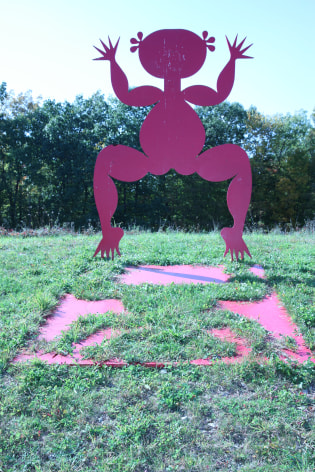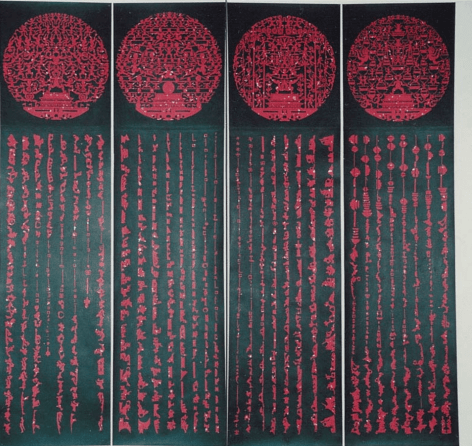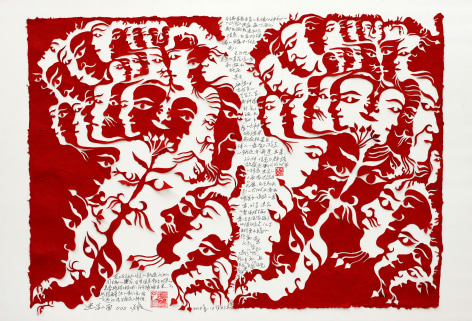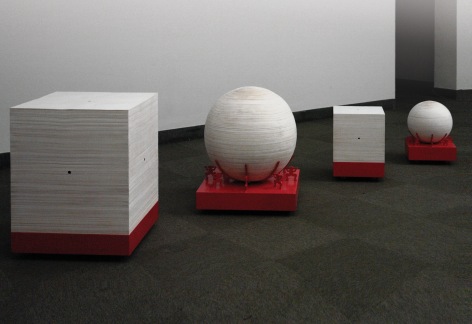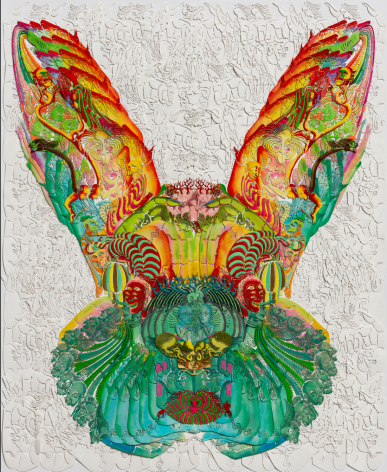Chambers Fine Art is pleased to announce the opening of The Cutting Edge of Lu Shengzhong. In the history of Chambers Fine Art, Lu Shengzhong (1952-2022) played a role of particular importance, both chronologically and as an indication of the guiding principles of the gallery after It was established in New York in 2000. This display of selected works is a tribute to Lu’s singular vision as an artist and as an influence on several generations of younger artists at the Central Academy of Fine Arts (CAFA), Beijing where he taught for many years.
When Christophe Mao made the decision to open a gallery devoted to contemporary Chinese art in the years immedIately before the millennium, there was an urgent need to identify a group of artists who did not conform to what had already become a stereotype in the West, the flashy oil paintings associated with Political Pop and Gaudy Art. When he was introduced to Lu in Beijing, he immediately felt that he would be an ideal candidate for his first exhibition of contemporary art as at that time the plan was to have alternate exhibitions of contemporary art and Classical Chinese art and scholar’s objects.
Born in Shandong Province China in 1952, Lu graduated from the Central Academy of Fine Arts in Beijing in 1987, where he had been associated with the Department of Folk Arts. Continuing his research, he made numerous trips in Shanxi Province and other areas where he developed considerable expertise in the tradition of paper-cuts pasted on walls, windows etc., particularly for Chinese New Year. He was the author of numerous books on the subject.
Simultaneously, he was establishing a reputation with his own remarkable paper cuts in which he said, he “walked away from the cultural confusion of the time and turned back to the villages, to traditional Chinese folk art.” He began working on a very large scale, as in the 1990 installation Hall of Calling the Soul filled with thousands of the “little red figures ” that were to become his signature as a paper cut artist.
The title of Lu Shengzhong’s first exhibition at Chambers Fine Arts, First Encounter (November 11, 2001 – January 2, 2002) refers not only to the first meeting between Christophe Mao and Lu Shengzhong but also to the introduction of Lu’s art to the United States. In the large vertical panels of Poetry of Harmony, lines of what appear to be Chinese characters are in fact left-over scraps of paper from the intricately cut circular forms at the top. The relationship between positive and negative forms is of crucial importance in Lu’s art. Favorably reviewed by Holland Cotter in the New York Times (January 5, 2001), he noted that Lu “used this fragile medium , notable for its lacey, intricate patterns, to create a temple-like installation.”
Two more exhibitions followed at Chambers Fine Art, Lu Shengzhong’s The Book of Humanity (November 6, 2003 – January 4, 2004) and Square Earth, Round Heaven Lu Shenzhong Works 2007. In the former, there were two series of works, sets of books in which red on black or black on red collages were gathered in book form, some with Western style bindings, some with traditional Chinese sewn bindings, and Human Bricks in which the hundreds of sheets of red paper from which“little red figures “ had been cut were assembled in multi-layered collages. In the latter, Lu moved into three dimensions, assembling multiple layers of paper into cubes and spheres, described by Robert E. Harriet, Jr., as the “visual and spatial correlates of round/heaven and square/earth that permeates Chinese art and architecture.
In his role as an educator, Lu became the director of the department of experimental art at CAFA in 2004 and retained that position until his retirement. Lu Shengzhong’s achievement as an artist was to develop the traditional Chinese craft of papercut in such a way that it was possible to use it not only for small scale individual works but also for installations of great complexity. For those who had the privilege to watch Lu Shengzhong at work, using his scissors with unerring skill so that complex designs in which positive and negative forms emerged effortlessly without any preliminary drawings, it was no suppose that the same gift could be used in the creation of three-dimensional versions of his “little red men.”
前波画廊诚挚地宣布吕胜中个展《吕胜中的创新(开拓)》在前波曼哈顿画廊及Artfarm展至2024年4月14日。纵观前波画廊的历史,无论是从开幕至今的时间点上,还是作为画廊指导性原则的风向标来说,吕胜中(1952 - 2022年)都扮演了至关重要的角色。此次展出的作品不仅是对吕胜中作为艺术家的致敬,也展示了其在中央美术学院任教多年的过程中对几代年轻艺术家产生的深远影响。
千禧年来临之际当茅为清决定开设一家致力于推广中国当代艺术的画廊时,他迫切寻找一群没有被西方模式化(例如与政治波普或艳俗艺术相关的油画)的艺术家。当时的计划是交替举办当代艺术、中国古美术、文人物件的展览。而在北京与吕胜中初次见面后,他立刻感觉到吕胜中是前波首次当代艺术展的理想人选。
吕胜中1952年出生于山东,1987年毕业于中央美术学院民间艺术系。他多次造访陕西及其他地区,继续深造和钻研了大量的剪纸传统,尤其是春节期间贴的窗花。他撰写了很多关于此类主题的书籍。
与此同时,其本人杰出的剪纸作品为其建立了声誉,他说,他“很快从遭受文化撞击的不知所措中抽身而出,又回到中国的乡村,去寻找古老的民间艺术”。他开始进行大规模的创作,比如1990年的装置作品《招魂堂》,其中成千上万个“小红人”之后成为了其作为剪纸艺术家的创作标志。
吕胜中在前波画廊的首次展览《初次见面》(2001年11月11日- 2002年1月2日)不仅代表了茅为清与吕胜中的初次相遇,也是其作品第一次远渡美国。在《和合诗》的大型垂直嵌板中,看似一排排的汉字,其实是顶部错综复杂的圆形图案剪剩的残余纸片。在吕胜中的作品中,正负两种形式的关系是至关重要的。霍兰德·考特在2001年1月5日的《纽约时报》上赞许了其作品,他指出吕胜中“运用了这种脆弱的媒材,以其花边和复杂的图案而闻名,创造了一个庙宇般的装置。”
之后前波画廊又为其举办了两次个展,分别是《人文书》(2003年11月6日- 2004年1月4日)和《地方天圆》(2007年9月6日—9月29日)。前者展出了两个作品系列,即将红底黑色图案或黑底红色图案的拼贴以书的形式装订在一起,有的采用西式装帧,有的采用中国传统的缝制装帧;而《人砖》则是将用数百张红纸剪出“小红人”以多层拼贴的形式组合在一起。 而在2007年的展览中,吕胜中将多层纸组装成立方体和球体,形成了三维的空间。韓文彬将其描述为“中国艺术和建筑中处处可见的天圆地方的视觉和空间关联”。
作为一名教育工作者,吕胜中2004年起担任中央美院实验艺术系主任,直至退休。 作为一名艺术家,吕胜中的成就在于发展了中国的传统剪纸工艺,不仅拘泥于小规模的个人作品,还延伸至极其复杂的大型装置。对于那些有幸目睹吕胜中创作过程的人来说,他在没有任何初步图纸的情况下,用剪刀精准且毫不费力地呈现出正负的复杂图案,然而意想不到的是同样的天赋竟也能用于创作其“小红人”的三维版本。

